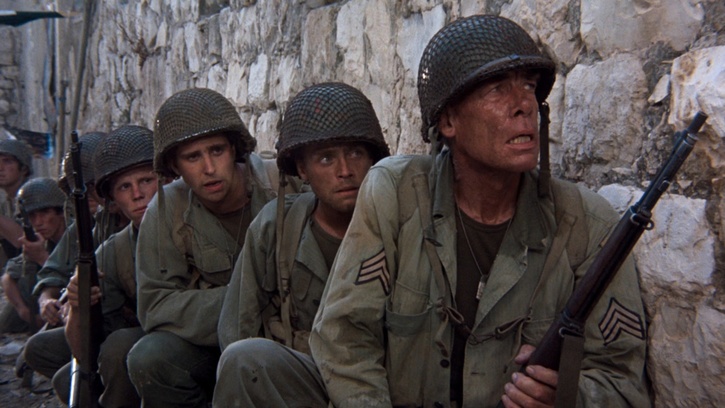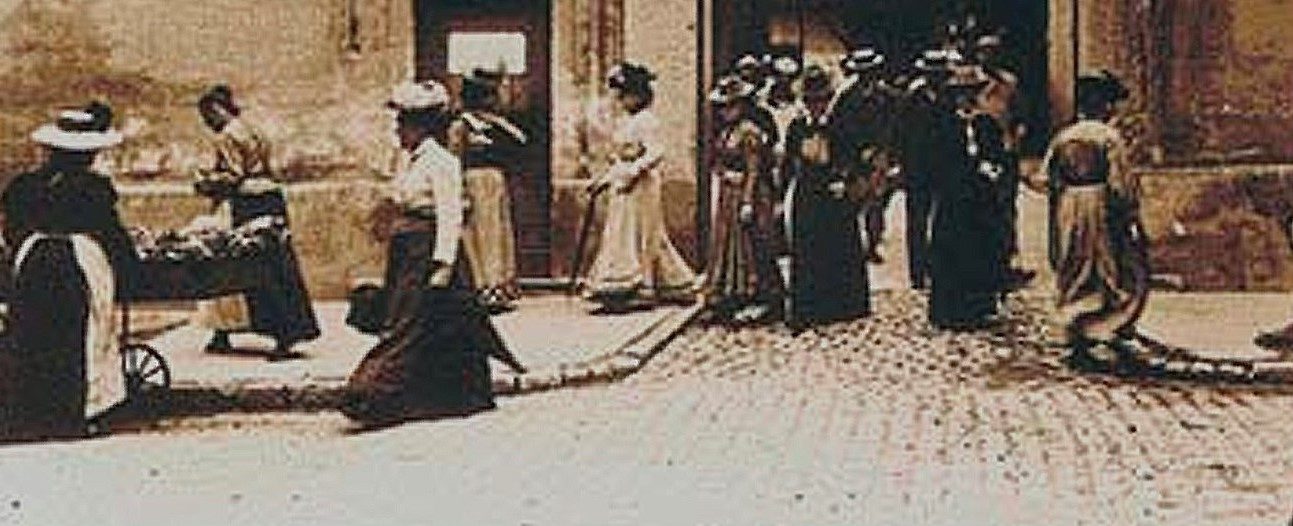United States, 1980
Directed by Samuel Fuller
With Lee Marvin (the Sergeant), Mark Hamill (Griff), Robert Carradine (Zab), Bobby Di Cicco (Vinci), Kelly Ward (Johnson), Siegfried Rauch (Schroeder)

The Big Red One is the nickname of the First Infantry Division of the US Army, which played a key role in the American effort to win World War Two. Four key moments of this war divide the narrative: the Allied forces’ landing on the North Africa coast in November 1942, on Sicily in July 1943, and then on Normandy in June 1944, along with the long-winded fight along the Belgian and French borders in the 1944-1945 winter, which led to the complete defeat of Nazi-ruled Germany (and the discovery of its concentration camps).
The events are viewed through the experience of the division’s First Squadron, and in particular through the eyes of two of its soldiers: Private Zab, a young author of pulp fiction hoping to emulate Ernest Hemingway, and the Sergeant leading the squad, a gruff veteran of World War One. As the rookie writer narrates the context and passes judgments on the conflict and the soldiers’ life, the non-commissioned officer is the focus of the camera and cuts a quiet but imposing figure; the former is a talkative and witty observer of the fight he was sent to, while the latter is a stolid and unnamed fighter doing his job and living his life.
The choice in “The Big Red One” the film not to give any type of name to the character, who is to be forever known only by his title and rank, is intriguing: should he be seen as an epitome, even if his attitudes and role make him an original and strong, if not entirely likable, character? It is easy to watch how the seasoned man of war stands at the opposite of ignorant civilians but the same events highlight the bonds those men create over time. A black and white prologue has introduced the Sergeant to the audience as an important character burdened by a fault (on the last day of the war in November 1918 he killed a German soldier who, unlike the American, was aware of that Armistice was signed, and hoped to be spared). No other background information is imparted on a man who is seemingly without remorse.
He keeps reminding his soldiers that they don’t murder, they just kill – a cold-blooded handling of the ungrateful task of war that he sticks to. Competence is the main thing defining him. But the last leg of the squadron’s mission casts a different light on the Sergeant, showing him sparing a young Nazi boy who managed to kill one of his men (the kid is spanked rather than executed), then trying to help a boy found in a concentration camp to survive (to no avail), and finally making the same mistake than in 1918, though in the new case his German victim turns out to be just badly wounded. So the moral monolith can crumble, and the man can avoid making errors and the film can end.
This is a convenient point to make – and to mock. The Sergeant feels like a lead character needed only to tell a long and sad story rightly (a war that still stands as an apex of dehumanization), and a walking tribute to a great kind of soldier (with precedents in director Samuel Fuller’s films, the 1951 movies “Fixed Bayonets!” and “The Steel Helmet”, both officially dedicated to the US Infantry and with key roles for sergeants – with a name). It may be dismissed or admired, depending perhaps on one’s opinion on war. The caption ending the opening credits could be the best guide of the film’s purpose, explaining that this is “a fictional life based on actual death”.
The vast sweep of events, reconstructed with the best means available for this production, covered by the 162-minute pic and the focused attention on personal suffering on every level, including the temptation of cowardice or the Shoah, turn the film into the fullest account possible of an essential part of the US involvement in the war. The film offers astonishing incidents (like the operation inside a mental hospital run by a female member of the Resistance) and gives to the American hero a perfect nemesis (fanatical Nazi officer Schroeder). They are part of a conflict that saw an entire generation coming into age, including the director himself. Fuller has wished to tell this story on a big scale and he even puts himself inside it; in his cameo, he shoots with a camera American soldiers and German kids as the winners arrive in the defeated country, a clear reenactment of his own role at the same place 35 years earlier. The Sergeant may be just a summary of many men of war Fuller met and his story belongs to his memory. And Zab’s voice is probably an echo to another young writer’ excited voice, Fuller’s own voice.
This epic as an abstract of personal experience has a visual flair that bolsters its ambitions, with breathtaking battle scenes shot as most as possible close to the fighter’s perspective (think of the scene featuring the arrival of Nazi tanks on a pass in North African desert and the need for the soldiers to dig a hole to hide away – but they flee as the fear of getting crushed by the vehicles is the strongest – and strongly conveyed). The most striking element in “The Big Red One” is the shooting of animals, and details that insert rather unexpected and still images in the midst of wider and wilder scenes. These pauses are also intriguing, breaking the tension and catching the audience’s attention by surprise; perhaps they reflect the absurd sensations the soldiers feel on the battleground; certainly they are compelling reminders that war simply coexist with the rest of the world.
War is another human experience, the most unfortunate it may be argued, but whose actuality cannot be dismissed and can be recorded by cinema, on personal terms as well as on broader ones. The urge to tell this story from a human angle drives the war movies of Fuller; and he clearly knows how to create characters and images serving his narrow but clear purpose; in this case, helped by the impressive performance of Lee Marvin, he gives the best of his talent.

